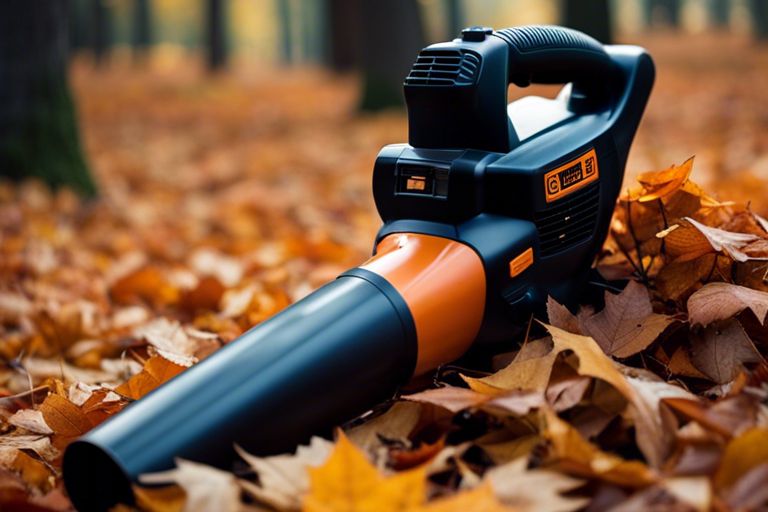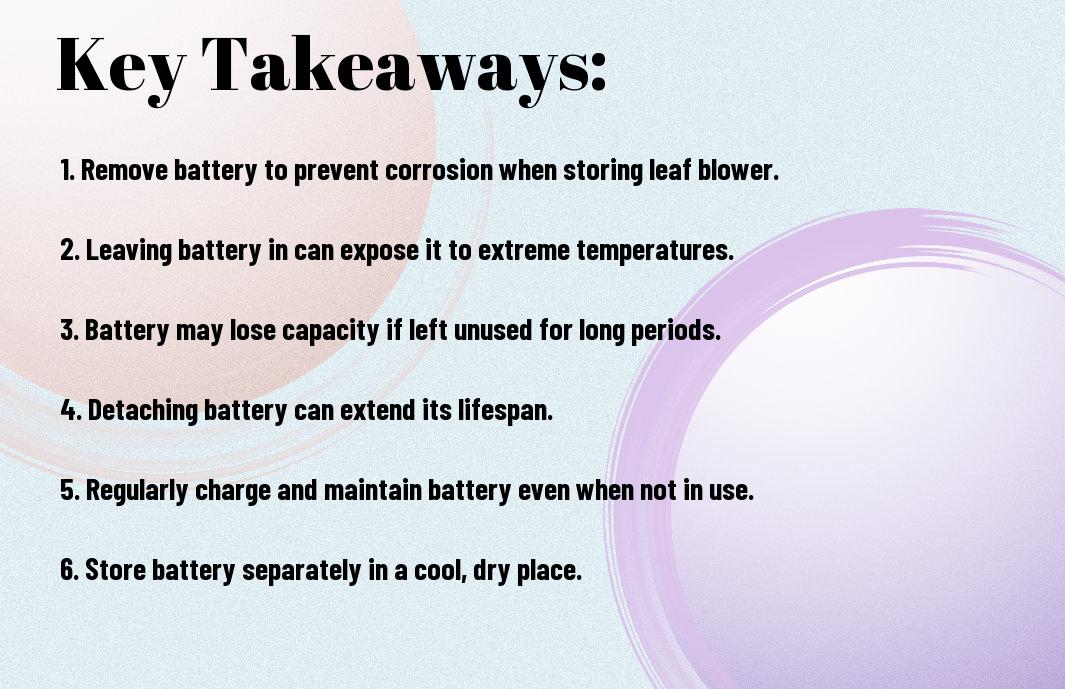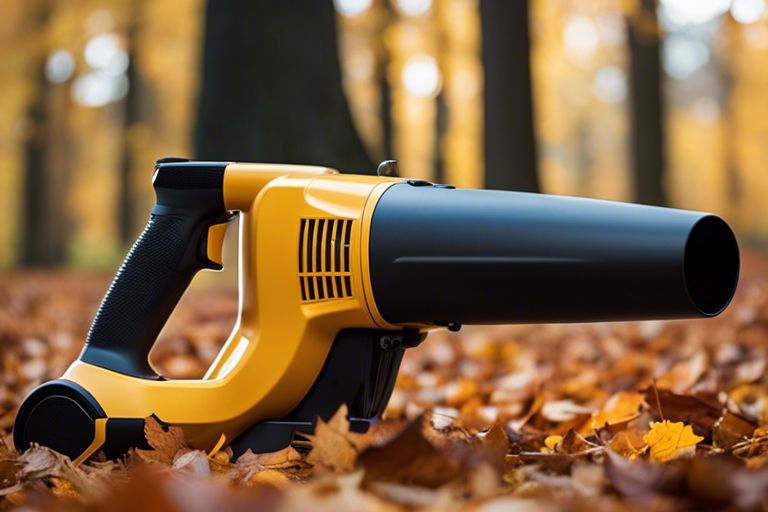Over the years, there has been some debate among gardeners and homeowners about whether it is safe and beneficial to leave the battery in a leaf blower when not in use. In this blog post, we aim to provide you with informative insights and guidance regarding this common question to help you make an informed decision that will optimize the performance and lifespan of your leaf blower.

Key Takeaways:
- Removal is not necessary: Leaving the battery in a leaf blower when not in use is generally safe and recommended by manufacturers.
- Longer battery life: Constant removal and reinstallation of the battery can lead to wear and tear, reducing its overall lifespan.
- Convenience and readiness: Keeping the battery in the leaf blower ensures it is always ready for use whenever needed, without the hassle of constant removal and storage.

Understanding Leaf Blower Batteries
While leaf blowers may seem like simple outdoor power equipment, understanding the batteries that power them is crucial for their optimal performance and longevity.
Types of Batteries Used in Leaf Blowers
- Lithium-ion (Li-ion)
- Nickel-cadmium (Ni-Cd)
- Nickel-metal hydride (Ni-MH)
- Lead-acid
- Lithium-ion polymer (LiPo)
With different types of batteries available for leaf blowers, it is important to choose the right one for your specific needs. The technology used in the battery can affect the power and runtime of the leaf blower. The voltage and amp-hour rating of the battery also play a crucial role in determining its performance. The maintenance requirements and lifespan of each type of battery may vary, so it is imperative to familiarize yourself with the characteristics of each.
Battery Maintenance and Longevity
Batteries are crucial components of leaf blowers, and proper maintenance is imperative to ensure their longevity and performance. It is important to follow the manufacturer’s guidelines for charging and storage to prevent overcharging or discharging, which can reduce the battery’s lifespan. Regularly inspecting the battery for any signs of damage or wear, such as leaks or corrosion, is also necessary. Storing the battery in a cool, dry place when not in use can help extend its lifespan. Additionally, using the correct charger designed for the specific battery type is important to prevent damage and ensure optimal performance.

Arguments for Removing the Battery
Safety Concerns
For safety reasons, it is advisable to remove the battery from a leaf blower when not in use. Leaving the battery attached to the device can increase the risk of accidents, especially in households with children or pets. Removing the battery ensures that the leaf blower cannot be accidentally turned on, preventing any potential injuries.
Preserving Battery Life
For extending the lifespan of the battery, taking it out of the leaf blower is recommended. Storing the battery separately in a cool, dry place away from direct sunlight can help protect it from damage and prolong its efficiency. Heat can degrade the battery cells over time, so removing it from the leaf blower after use can prevent overheating and ensure a longer battery life.
Understanding the importance of preserving the battery life can save you money in the long run. Lithium-ion batteries, commonly used in leaf blowers, can deteriorate faster if exposed to extreme temperatures or left in a depleted state. By removing the battery when not in use and following proper storage guidelines, you can maximize its performance and avoid the need for frequent replacements.
Arguments for Keeping the Battery In
Readiness and Convenience
Convenience is a key benefit of leaving the battery in your leaf blower. By keeping the battery inside the blower, you ensure that it is always ready for use whenever you need it. This eliminates the hassle of having to search for the battery and insert it each time you want to use the tool, saving you time and effort in the long run.
Counterpoints to Safety and Battery Life Concerns
Any concerns about safety and battery life can be mitigated by following proper storage and usage guidelines provided by the manufacturer. Modern leaf blowers are designed to safely store the battery while also ensuring optimal battery performance. As long as you adhere to the recommended maintenance practices, leaving the battery in should not pose a significant risk to your safety or the lifespan of the battery.
Understanding the capabilities of your specific leaf blower model and the manufacturer’s recommendations is crucial in making an informed decision about whether to leave the battery in. Consider factors such as the design of the tool, the quality of the battery, and the intended usage to determine the best course of action for maximizing both convenience and safety.
Best Practices for Battery Management
Charging and Storage Tips
All battery-powered tools, including leaf blowers, require proper management for optimal performance and longevity. With respect to charging your leaf blower battery, always follow the manufacturer’s instructions to prevent overcharging. For storage, keep the battery in a cool, dry place away from direct sunlight and moisture to prevent any damage. Remove the battery from the leaf blower before storing it.
- Avoid overcharging the battery
- Store the battery in a cool, dry place
- Keep the battery away from direct sunlight and moisture
Recognizing the importance of proper charging and storage practices can significantly extend the lifespan of your leaf blower battery and ensure its efficient performance over time.
Seasonal Considerations
Practices for maintaining your leaf blower battery’s health may vary depending on the season. With changing temperatures, it’s crucial to adjust your battery management accordingly. Extreme heat or cold can affect the battery’s performance, so be mindful of storing the battery in temperatures recommended by the manufacturer. Additionally, before storing your leaf blower for an extended period, make sure to fully charge the battery and disconnect it from the tool.
Summing up
On the whole, it is better to remove the battery from a leaf blower when not in use. Storing the battery separately will help extend its lifespan and prevent potential damage from moisture, extreme temperatures, or accidental activation. By following this simple practice, you can ensure that your leaf blower remains in good working condition for a longer period of time.
FAQ
Q: Is it okay to leave the battery in a leaf blower all the time?
A: It is generally recommended to remove the battery from a leaf blower when not in use to prevent potential damage from overcharging or discharging.
Q: Can leaving the battery in a leaf blower shorten its lifespan?
A: Yes, leaving the battery in a leaf blower for extended periods without use can lead to decreased battery life and efficiency over time.
Q: How should I store the battery if I am not using the leaf blower for a long time?
A: When storing a leaf blower for an extended period, it is best to remove the battery and store it in a cool, dry place away from direct sunlight.
Q: What are the potential risks of leaving the battery in a leaf blower constantly?
A: Leaving the battery in a leaf blower for prolonged periods can result in overcharging, overheating, and potentially damaging the battery cells, leading to a shortened battery lifespan.
Q: How can I ensure the longevity of my leaf blower battery?
A: To maximize the lifespan of your leaf blower battery, remember to remove it when not in use, store it properly, and follow the manufacturer’s guidelines for charging and maintenance.
